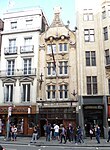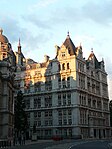Craig's Court

Craig's Court is a courtyard off Whitehall in central London containing the grade II* listed Harrington House (c.1692), other listed buildings, and the British Telecom Whitehall telephone exchange of which Harrington House forms a part. It was built by Joseph Craig in the late 1690s on land that had once been the location of the Hermitage of St Katherine. The Court is entered through a narrow single-track road in which the carriage of the Speaker of the House of Commons once got stuck and which is often overlooked by tourists. The Sun Fire Office had offices there from 1726 and army agents Cox & Company were located there for over 150 years. Former residents include the memoirist Teresia Constantia Phillips (1748–49) and the painter George Romney in the 1760s, but the only remaining original building is Harrington House.
Excerpt from the Wikipedia article Craig's Court (License: CC BY-SA 3.0, Authors, Images).Craig's Court
Craig's Court, London Covent Garden
Geographical coordinates (GPS) Address Nearby Places Show on map
Geographical coordinates (GPS)
| Latitude | Longitude |
|---|---|
| N 51.5067 ° | E -0.1266 ° |
Address
Whitehall Telephone Exchange
Craig's Court
SW1A 2BS London, Covent Garden
England, United Kingdom
Open on Google Maps










